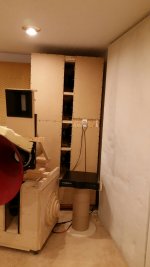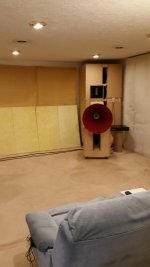Hi all, Just found this thread. In the discussion of dipole bass, I've not seen mention of the room interaction. I think we could all agree that the room is the largest factor in bass response. Dipole radiation will excite half of the room modes and greatly reduce that bass bump that we all have become used to. With this room resonance reduced the bass has much more definition.
@OP
dipole top-to-bottom design has already been accomplished by Linkwitz in LX521. He also shared the speaker design theory as a big proponent of dipole.
Moreover SL and john Kreskowsky practically converged on an optimal baffle shape for an 8+4" driver combo to deliver target off axis dispersion.
p.s. we also remember the rear tweeter discussion between the two and how SL changed his mind and John felt he was not given enough credit as "the first" and so on. I find your write up about baffle thickness impact and placing tweeters next to each other a complete repeat of already known.
> You should clearly state design goals which are your original contribution please.
Are you going to define an optimal baffle shape with a planar tweeter?
Is your target a different vertical dispersion?
or ...?
I have both the Linkwitz designs and also my home brewed 3 way OB.
My goal for example was to make a more sensitive speaker so I could use my low wattage class A amps; and, of course, to learn something in the process .
.
dipole top-to-bottom design has already been accomplished by Linkwitz in LX521. He also shared the speaker design theory as a big proponent of dipole.
Moreover SL and john Kreskowsky practically converged on an optimal baffle shape for an 8+4" driver combo to deliver target off axis dispersion.
p.s. we also remember the rear tweeter discussion between the two and how SL changed his mind and John felt he was not given enough credit as "the first" and so on. I find your write up about baffle thickness impact and placing tweeters next to each other a complete repeat of already known.
> You should clearly state design goals which are your original contribution please.
Are you going to define an optimal baffle shape with a planar tweeter?
Is your target a different vertical dispersion?
or ...?
I have both the Linkwitz designs and also my home brewed 3 way OB.
My goal for example was to make a more sensitive speaker so I could use my low wattage class A amps; and, of course, to learn something in the process
pixelpusher, how about post #21
Dipole low bass is not common and many of us don't have much practical experience - me neither! Lack of sideways sound pressure is one phrase that we hear often. It sure has some influence also in-a-room, but is very difficut to study and measure. All bass measurements need long IR gating and thus include huge amount of reflections and modes. And our perception off bass sound is even more complicated, but also clever!
I guess everyone here knows John Reekie's studies and measurements? He recommends placing any subwoofer near the listener. That is definitely best scenario, but not realistic and easy. Perhaps not best for upper bass either...
On Dipole Subwoofer Placement
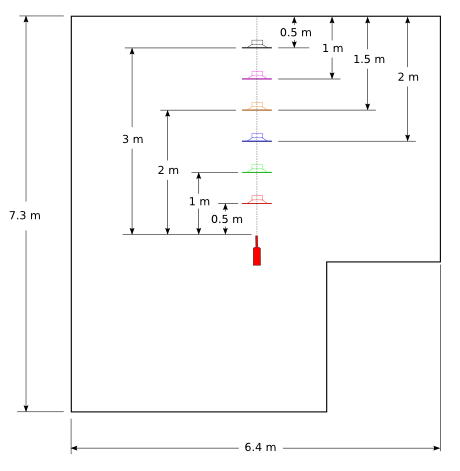
When I met S Linkwitz he persuaded me to try dipole bass, with a grin on his face. I said no, I don't have large enough room for that. I have heard 2x12" H-panel stereo dipole woofers with dsp at friend's exceptionally well damped cellar room and yes - bass was good. Perhaps I should build protos and try those too, instead of just trying to be the sharpest pencil in the box...
Dipole low bass is not common and many of us don't have much practical experience - me neither! Lack of sideways sound pressure is one phrase that we hear often. It sure has some influence also in-a-room, but is very difficut to study and measure. All bass measurements need long IR gating and thus include huge amount of reflections and modes. And our perception off bass sound is even more complicated, but also clever!
I guess everyone here knows John Reekie's studies and measurements? He recommends placing any subwoofer near the listener. That is definitely best scenario, but not realistic and easy. Perhaps not best for upper bass either...
On Dipole Subwoofer Placement

When I met S Linkwitz he persuaded me to try dipole bass, with a grin on his face. I said no, I don't have large enough room for that. I have heard 2x12" H-panel stereo dipole woofers with dsp at friend's exceptionally well damped cellar room and yes - bass was good. Perhaps I should build protos and try those too, instead of just trying to be the sharpest pencil in the box...
Last edited:
I am no engineer so I always look to 'steal' design ideas. Hasn't this already been done by Kyron Audio specifically their Gaia speaker? I have not heard them - has anyone? - but they get good reviews. It looks like they are using Acoustic Elegance woofers that were designed for OB.
Now I found this Kreskowsky's article again, nice!
Dipole_modesA
More popular science in this article by Reekie
Prototyping a Dipole Bass System
Dipole_modesA
More popular science in this article by Reekie
Prototyping a Dipole Bass System
@OP
dipole top-to-bottom design has already been accomplished by Linkwitz in LX521. He also shared the speaker design theory as a big proponent of dipole.
Moreover SL and john Kreskowsky practically converged on an optimal baffle shape for an 8+4" driver combo to deliver target off axis dispersion.
p.s. we also remember the rear tweeter discussion between the two and how SL changed his mind and John felt he was not given enough credit as "the first" and so on. I find your write up about baffle thickness impact and placing tweeters next to each other a complete repeat of already known.
> You should clearly state design goals which are your original contribution please.
Are you going to define an optimal baffle shape with a planar tweeter?
Is your target a different vertical dispersion?
or ...?
I have both the Linkwitz designs and also my home brewed 3 way OB.
My goal for example was to make a more sensitive speaker so I could use my low wattage class A amps; and, of course, to learn something in the process.
Um, no. Linkwitz LX521 is not truly fully dipole, he just uses drivers "open". For example, he crosses over to the tweeters at 7kHz. There is no way that the small cone covering the band below has rear radiation up to 7kHz that is anything like what is coming out of the front of the cone. I have asked him about the importance of what was coming out towards the "rear" in the past and he said he was just content to "let the sound out" and eliminate cabinet resonances (at the time, this was in about 2007). He didn't seem to care much about what was happening to the rear, and I have not seen any mention or measurement of the rear output of the LX521 from him on his web site or anywhere for that matter.
Also, if your question was for me, the "optimal" baffle shape is NO BAFFLE, period. As soon as you start adding some baffle, you disturb the off axis frequency response. This can be confirmed with both modeling and measurements. I got the idea that SL realized this after he had designed the LX521, for which he was already using as small a baffle as possible to be structurally sound. It's barely a few inches around the drivers, really. But there is no "magic" to its shape. He says he arrived at it "emperically". He told me he just kept sawing off material and remeasuring! In the end it became as small as possible to keep the off axis radiation patterns like the on axis ones.
It's not simple to use "no baffle" - what is holding up the drivers then? You have to take a completely different approach to constructing the loudspeaker, physically. I posted some data taken from his web site to support my "no baffle" position earlier in this thread if you want to go back and look at it.
So, yes, I am really, truly, actually trying for symmetric front-rear dipole radiation patterns over the entire audio band, or as much of it as the loudspeaker can cover. I am using nude drivers except for below 100Hz where I will use an H-frame dipole sub. That's not 100% new, either, just for full disclosure. People were doing this some time ago LIKE THIS SYSTEM, and I got me thinking about why anyone would want to do that kind of thing. Now I am a proponent myself.
Saying that this has all been figured out before by Linkwitz, Kreskovsky, and others is like saying that there is nothing new in amplifier design and that hasn't been done before. There are many subtleties that can be massaged into something that has better performance. And it is not a sin to repeat and emphasize the design principles in this DIY forum. It is not like I am claiming patent rights or something. I thought this thread would stimulate some POSITIVE discussion on the topic, especially about the rear radiation, which I feel is largely overlooked by most OB/dipole builders.
on the subject of bass, dipole vs other:
this is also an old discussion. any number of known speaker designers already stated that the outcome was completely room dependent. My experience is the same.
I have both. I enjoy string bass on my OBs (15 inchers driven by a dedicated amp). However I find that due to their size and off the wall mid requirement my OBs are a lot more prohibitive of trying different in-room placement which has a huge effect on bass. Thus I can get a much better result with a 12inch subwoofer (back loaded horn; design off Beyma website) placed in a corner. Plays lower, bass rock solid with no bloom and impossible to point to subjectively.
I did not try any software for room EQ like Dirac etc. that may be the next step (though really not necessary in the one particular listening space; I think having irregular size room open to other rooms and angled walls and different ceiling heights etc. helps a lot more).
In a more conventional rectangular setting i listened to a 3 sub setup Geddes had in his house and he also had achieved a very good result. A white paper discussing room effects and multiple sub setup was available before at Harman site (too lazy to look for it now).
this is also an old discussion. any number of known speaker designers already stated that the outcome was completely room dependent. My experience is the same.
I have both. I enjoy string bass on my OBs (15 inchers driven by a dedicated amp). However I find that due to their size and off the wall mid requirement my OBs are a lot more prohibitive of trying different in-room placement which has a huge effect on bass. Thus I can get a much better result with a 12inch subwoofer (back loaded horn; design off Beyma website) placed in a corner. Plays lower, bass rock solid with no bloom and impossible to point to subjectively.
I did not try any software for room EQ like Dirac etc. that may be the next step (though really not necessary in the one particular listening space; I think having irregular size room open to other rooms and angled walls and different ceiling heights etc. helps a lot more).
In a more conventional rectangular setting i listened to a 3 sub setup Geddes had in his house and he also had achieved a very good result. A white paper discussing room effects and multiple sub setup was available before at Harman site (too lazy to look for it now).
Last edited:
The big deal in what Charlie is aiming for is to construct a single multiway-loudspeaker , which has dipole radiation 20-20kHz. It is too easy to separate a subwoofer or a tweeter from this and optimize it, and measure it in optimal conditions.
As Charlie said it will most propably be a 4-way speaker like LX521 or NaO Note. Besides radiation we must fight distortion.
Then, how do we optimize and measure, evaluate the operation and sound? For measurements, it should stand on a pole on open field. If response is flat there 20-20k on-axis and sideways, nulling sideways and again mirroring radiation up to 180¤, it is ideal. Don't forget vertical and oblique directions!
But when that speaker is carried inside a normal listening/living room, it won't have ideal room response! There are reflections and modes which are very spescific to location of the speaker and the microphone or listener. How and what to measure and adjust? Do we change response or direcitivity?
And add strereo imaging and other perceptual psychoacoustic issues to that, we can't even measure how a speaker sounds really! Which measurement do we take and look at? Can we arrange a listener panel and even ABX or other blind test?
Take one step at the time, but follow the trail!
As Charlie said it will most propably be a 4-way speaker like LX521 or NaO Note. Besides radiation we must fight distortion.
Then, how do we optimize and measure, evaluate the operation and sound? For measurements, it should stand on a pole on open field. If response is flat there 20-20k on-axis and sideways, nulling sideways and again mirroring radiation up to 180¤, it is ideal. Don't forget vertical and oblique directions!
But when that speaker is carried inside a normal listening/living room, it won't have ideal room response! There are reflections and modes which are very spescific to location of the speaker and the microphone or listener. How and what to measure and adjust? Do we change response or direcitivity?
And add strereo imaging and other perceptual psychoacoustic issues to that, we can't even measure how a speaker sounds really! Which measurement do we take and look at? Can we arrange a listener panel and even ABX or other blind test?
Take one step at the time, but follow the trail!
Last edited:
A while ago I made some measurements of naked drivers to evaluate the usability as dipole drivers. The response was eq'd to flat as much as possible without overdoing it with regards to filter use. The reason for this is to see the effect of compensating for the dipole losses on the harmonic distortion.
Four Vifa TC9 in an alternating arrangement:
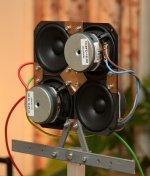
The normalised directivity measured in 5 degree steps from full front to back (37 measurements) and mirrored for a 360 degree view:
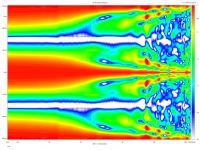
The harmonic distortion measured at 50cm and 95dBSPL:
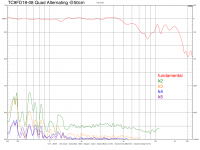
A Scan-Speak 18WU/8741T00:
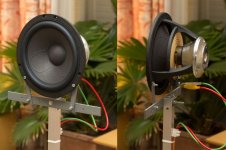
And the measurements:
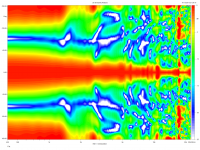
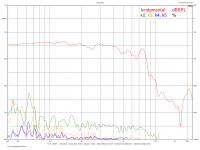
The harmonics are in % with the scale on the right.
As this was measured in room I don't know what the validity is of the harmonics below ~800Hz.
I was pleasantly surprised by the performance of the Vifa and somewhat disappointed by the Scan Speak. The response of the Scan speak is quite irregular and the the open frame with the beautifully shaped magnet does not live up to expectations, the front-back symmetry is not going beyond 1.5kHz.
Four Vifa TC9 in an alternating arrangement:

The normalised directivity measured in 5 degree steps from full front to back (37 measurements) and mirrored for a 360 degree view:

The harmonic distortion measured at 50cm and 95dBSPL:

A Scan-Speak 18WU/8741T00:

And the measurements:


The harmonics are in % with the scale on the right.
As this was measured in room I don't know what the validity is of the harmonics below ~800Hz.
I was pleasantly surprised by the performance of the Vifa and somewhat disappointed by the Scan Speak. The response of the Scan speak is quite irregular and the the open frame with the beautifully shaped magnet does not live up to expectations, the front-back symmetry is not going beyond 1.5kHz.
John and Charlie
I appreciate you guys. You have both brought up several very good points and great discussion topics. I'd be doing great to respond to at least 1/2 of them.
From John,
"I get the sense you have yet to hear a properly designed Open Baffle."
My answer: no doubt. Well I was going to use my experience of listening to the LX-531 as one of them, but upon further reading here, I see that is now invalid.
Every once in a while, I do get out to Houston. If your Hill country is the same as what I think Hill Country is, I do enjoy visiting there. A guy named Pete lives there and played his ORIS based horn system for me. (got me hooked)
"Design a subwoofer, 18” class driver of course, that will play flat to 32 Hz with a net efficiency of at least 1% (92 dbw) capable of delivering a minimum of 1 acoustic watt (109 db) at 32 Hz at one meter without exceeding Xmax"
My answer:
I know of a driver which will indeed perform, and it ain't cheap. Around 8 cubic feet. Is that big ? Some would consider that big, too big, whatever, but I call that a moderate size.
From Charlie:
(Scott, the BR has relatively poor transient response, even when "done right". For an 18" driver the box will need to be very large in order to keep the port length, and therefore port resonances, to a minimum. It must be the size of a big refrigerator if you want low tuning (e.g. 20Hz or less). And it will need some good bracing to keep the walls stiff. It won't be very portable...........
SL in one of his last talks at Burning Amp mentioned how he strongly dislikes reflex designs and felt that they all had "boom", e.g. the resonator droned on excessively when excited by the driver. He probably never heard one "done right" I guess.)
The question of 20Hz extension and *poor transient response* of bass reflex, is another battle, for another time. Sadly, SL never made it to my home such that I could open his ears to something that works well, despite his beliefs. He fully admits in his videos, that he is biased FOR the case of open baffles. He only shared his work in case others held that same preference. He never intended it to be a contest to prove the superiority of such devices known as open baffles.
Sadly, I have no connections to the Glove State, so no trips for me in the foreseeable future.
I've never had a problem with any of my fellow DIY'ers having a preference for open baffle bass. To each their own, for sure. It's all a matter of taste. It's only when the soapbox mount takes place with outrageous claims of 25Hz bass from an 18inch wide baffle, and the usually Clayton Shaw type of sales pitch that all boxes sound like resonant boxes, that gets my fur to stand up.
If I had another room, I would look into designing some open baffle bass. If for nothing more than to exhibit the design. One of my best audio buddies is a HUGE open baffle fan. It took many years, but he is now convinced that adding sealed box bass to his system is a wise choice. He has ported box phobia; a really bad case. He used to have crossover phobia too, but since listening to my superb 4-way active system, said phobia has now been quelled.
Attached photo is of right hand side only. It's boxed bass. The left side is infinite baffle bass, it can not bee seen in this picture. There is not even the slightest hint of boxiness/boominess in my sound system. It only plays music that sounds as close to live, as any you might encounter.
I appreciate you guys. You have both brought up several very good points and great discussion topics. I'd be doing great to respond to at least 1/2 of them.
From John,
"I get the sense you have yet to hear a properly designed Open Baffle."
My answer: no doubt. Well I was going to use my experience of listening to the LX-531 as one of them, but upon further reading here, I see that is now invalid.
Every once in a while, I do get out to Houston. If your Hill country is the same as what I think Hill Country is, I do enjoy visiting there. A guy named Pete lives there and played his ORIS based horn system for me. (got me hooked)
"Design a subwoofer, 18” class driver of course, that will play flat to 32 Hz with a net efficiency of at least 1% (92 dbw) capable of delivering a minimum of 1 acoustic watt (109 db) at 32 Hz at one meter without exceeding Xmax"
My answer:
I know of a driver which will indeed perform, and it ain't cheap. Around 8 cubic feet. Is that big ? Some would consider that big, too big, whatever, but I call that a moderate size.
From Charlie:
(Scott, the BR has relatively poor transient response, even when "done right". For an 18" driver the box will need to be very large in order to keep the port length, and therefore port resonances, to a minimum. It must be the size of a big refrigerator if you want low tuning (e.g. 20Hz or less). And it will need some good bracing to keep the walls stiff. It won't be very portable...........
SL in one of his last talks at Burning Amp mentioned how he strongly dislikes reflex designs and felt that they all had "boom", e.g. the resonator droned on excessively when excited by the driver. He probably never heard one "done right" I guess.)
The question of 20Hz extension and *poor transient response* of bass reflex, is another battle, for another time. Sadly, SL never made it to my home such that I could open his ears to something that works well, despite his beliefs. He fully admits in his videos, that he is biased FOR the case of open baffles. He only shared his work in case others held that same preference. He never intended it to be a contest to prove the superiority of such devices known as open baffles.
Sadly, I have no connections to the Glove State, so no trips for me in the foreseeable future.
I've never had a problem with any of my fellow DIY'ers having a preference for open baffle bass. To each their own, for sure. It's all a matter of taste. It's only when the soapbox mount takes place with outrageous claims of 25Hz bass from an 18inch wide baffle, and the usually Clayton Shaw type of sales pitch that all boxes sound like resonant boxes, that gets my fur to stand up.
If I had another room, I would look into designing some open baffle bass. If for nothing more than to exhibit the design. One of my best audio buddies is a HUGE open baffle fan. It took many years, but he is now convinced that adding sealed box bass to his system is a wise choice. He has ported box phobia; a really bad case. He used to have crossover phobia too, but since listening to my superb 4-way active system, said phobia has now been quelled.
Attached photo is of right hand side only. It's boxed bass. The left side is infinite baffle bass, it can not bee seen in this picture. There is not even the slightest hint of boxiness/boominess in my sound system. It only plays music that sounds as close to live, as any you might encounter.
Attachments
A while ago I made some measurements of naked drivers to evaluate the usability as dipole drivers. The response was eq'd to flat as much as possible without overdoing it with regards to filter use. The reason for this is to see the effect of compensating for the dipole losses on the harmonic distortion.
Four Vifa TC9 in an alternating arrangement:
...
The normalised directivity measured in 5 degree steps from full front to back (37 measurements) and mirrored for a 360 degree view:
...
The harmonic distortion measured at 50cm and 95dBSPL:
...
A Scan-Speak 18WU/8741T00:
...
And the measurements:
...
The harmonics are in % with the scale on the right.
As this was measured in room I don't know what the validity is of the harmonics below ~800Hz.
I was pleasantly surprised by the performance of the Vifa and somewhat disappointed by the Scan Speak. The response of the Scan speak is quite irregular and the the open frame with the beautifully shaped magnet does not live up to expectations, the front-back symmetry is not going beyond 1.5kHz.
I had a similar experience to what you measured with the Scan-Speak mdiwoofer, except using a 5" SB Acoustics Satori midwoofer. It's an excellent driver, but not for dipole use! That sexy neo magnet and basket, which look like they would be perfect for dipole use, don't result in a very usable response overall. Very disappointing!
Apart from having a more open basket and not too large a magnet, I find it challenging to determine whether a home audio driver (e.g. 5"-10" diameter) is a good dipole candidate just by looking at it. I have definitely been unpleasantly surprised on several occasions.
Thanks for sharing your plots by the way.
"Design a subwoofer, 18” class driver of course, that will play flat to 32 Hz with a net efficiency of at least 1% (92 dbw) capable of delivering a minimum of 1 acoustic watt (109 db) at 32 Hz at one meter without exceeding Xmax"
... I know of a driver which will indeed perform, and it ain't cheap. Around 8 cubic feet. Is that big ? Some would consider that big, too big, whatever, but I call that a moderate size.
Driver details please, website, price, reviews....?
Thanks.
Alex.
What I'd like to see is a simple real-world empirical test of the notion held firmly by some textbook obsessed people that the rear wave sneaks around and destroys the front wave. In the Olson's textbook, as I poorly recall it now, he used a circular baffle - obviously the worst kind for audio quality but showing the most dramatic cancellation.
As John Busch posted, "I think you are blinded by your perception of “acoustic short circuit” negatives, not the positives the “acoustic short circuit” can provide."
What really happens when you have a OB speaker in some proximity to a wall? Does the textbook model predominate or are the waves all dancing about in random phase?
Seems an easy question for somebody in some room to measure.
Since I believe the random-wave outcome (and have experience as my guide), I think it would be great to have the hobgoblin of wave annihilation put to rest... or at least evaluated properly.
B.
As John Busch posted, "I think you are blinded by your perception of “acoustic short circuit” negatives, not the positives the “acoustic short circuit” can provide."
What really happens when you have a OB speaker in some proximity to a wall? Does the textbook model predominate or are the waves all dancing about in random phase?
Seems an easy question for somebody in some room to measure.
Since I believe the random-wave outcome (and have experience as my guide), I think it would be great to have the hobgoblin of wave annihilation put to rest... or at least evaluated properly.
B.
Very odd that I can't recall seeing any mention working in harmony with a very important design feature: driver resonance. After all, an OB lets the driver speak for itself.
A few years ago, I built an OB sub using a driver with a low-20s resonance and large irregularly shaped open baffle. The resulting sound compass was quite nice because it enlisted the driver resonance in the output.*
So working with that resonance can result in a beneficially shaped output.
B.
* I wish I could find the thread... if we had a better search tool here See EDIT below. While reversing polarity changed the sound a bit (with the mids connected, obviously), I never thought one polarity was better than the reverse. Sort of support for my random-wave way of looking at real rooms.
EDIT:
Hid a large open baffle low woofer
A few years ago, I built an OB sub using a driver with a low-20s resonance and large irregularly shaped open baffle. The resulting sound compass was quite nice because it enlisted the driver resonance in the output.*
So working with that resonance can result in a beneficially shaped output.
B.
* I wish I could find the thread... if we had a better search tool here See EDIT below. While reversing polarity changed the sound a bit (with the mids connected, obviously), I never thought one polarity was better than the reverse. Sort of support for my random-wave way of looking at real rooms.
EDIT:
Hid a large open baffle low woofer
Last edited:
Very odd that I can't recall seeing any mention working in harmony with a very important design feature: driver resonance. After all, an OB lets the driver speak for itself.
A few years ago, I built an OB sub using a driver with a low-20s resonance and large irregularly shaped open baffle. The resulting sound compass was quite nice because it enlisted the driver resonance in the output.
So working with that resonance can result in a beneficially shaped output.
B.
The usefulness in a dipole application would depend on the Q of said 20Hz resonance!
It is definitely advantageous to employ a "high Q" driver used down into its resonance region in a OB or dipole system.
Last edited:
The usefulness in a dipole application would depend on the Q of said 20Hz resonance!
It is definitely advantageous to employ a "high Q" driver used down into its resonance region in a OB or dipole system.
Quite true. But hard to think of any impedance curve that I've even measured that wouldn't be plenty swell. That is, we might be looking at something quite compatible with a Linkwitz transform. Anyway, the speaker ain't done until the DSP EQ is done and so the resonance just adds to the mix.
Granted, the devil to model, for those who sleep better if they can model something.
B.
Maximise audio quality and minimise room interaction...
My emphasis in bold.... Why the heck would you want do do that?
Choosing NOT to use DSP crossovers / Eq crossovers.... you want to make a 1919 open baffle instead of a 2019 design?
You want to drag loudspeakers out into lounge.... Apart from the tiny minority of audiophiles who dedicate their man cave to stereo music ( nothing wrong with that by the way!) modern lounges host TV, movies, game consoles etc... Small sub sat systems, soundbars dominate.
If you are aiming to maximise audio quality and minimise room interaction, on wall or even better in wall loudspeakers are the way to go.
The best high end studio rigs (often post production and mastering houses) use soffit mounted active monitors to achieve the best sound.
Cheers
Alex.
One thing I would like you to do, just for giggles. Design a subwoofer, 18” class driver of course, that will play flat to 32 Hz with a net efficiency of at least 1% (92 dbw) capable of delivering a minimum of 1 acoustic watt (109 db) at 32 Hz at one meter without exceeding Xmax. (Half space mesurement) Make sure it can do that sitting on the floor away from the rear wall, say 24” to minimize standing waves (exciting the room). Plug and play. No EQ other than passive. Something you can drive with any competent HiFi stereo amplifier.
My emphasis in bold.... Why the heck would you want do do that?
Choosing NOT to use DSP crossovers / Eq crossovers.... you want to make a 1919 open baffle instead of a 2019 design?
You want to drag loudspeakers out into lounge.... Apart from the tiny minority of audiophiles who dedicate their man cave to stereo music ( nothing wrong with that by the way!) modern lounges host TV, movies, game consoles etc... Small sub sat systems, soundbars dominate.
If you are aiming to maximise audio quality and minimise room interaction, on wall or even better in wall loudspeakers are the way to go.
The best high end studio rigs (often post production and mastering houses) use soffit mounted active monitors to achieve the best sound.
Cheers
Alex.
My emphasis in bold.... Why the heck would you want do do that?
Choosing NOT to use DSP crossovers / Eq crossovers.... you want to make a 1919 open baffle instead of a 2019 design?
You want to drag loudspeakers out into lounge.... Apart from the tiny minority of audiophiles who dedicate their man cave to stereo music ( nothing wrong with that by the way!) modern lounges host TV, movies, game consoles etc... Small sub sat systems, soundbars dominate.
If you are aiming to maximise audio quality and minimise room interaction, on wall or even better in wall loudspeakers are the way to go.
The best high end studio rigs (often post production and mastering houses) use soffit mounted active monitors to achieve the best sound.
Cheers
Alex.
I would guess that John is very proud of the fact that he CAN pull off an open baffle design with a passive crossover. Given the right driver, the right baffle, and a good deal of experience, you CAN do it.
Honestly, I do sometimes admire the tricks that the experts can pull off with a low parts count passive crossover and the right driver. I am a DSP guy, and love the flexibility of that type of crossover, but passive crossovers still have their place under the sun.
- Home
- Loudspeakers
- Multi-Way
- In Pursuit of a 20-20k Dipole Loudspeaker
